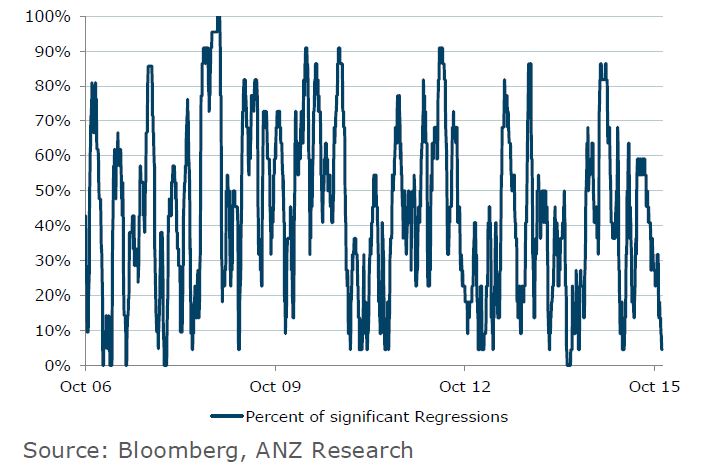Australian Dollar Forecast Lower by ANZ as Commodity Slump, Housing Finance Cools
The Aussie dollar cannot defy the slump in commodity prices for much longer say ANZ Research in their latest assessment of the currency.

Commodity prices remain supressed yet the Australian dollar, which derives much of its value from Australia’s commodity exports, continues to maintain levels well ahead of where we would expect.
Meanwhile, fresh data confirming a decline in lending to the property sector could invite further RBA action we believe.
The currency remains elevated; the pound to Australian dollar exchange rate (GBPAUD) has fallen from 2.23 back in August to present levels noted at 2.0714 on the back of this AUD strength.
In fact some banks are now transferring money at an exchange rate at and just below the psychologically important level of 2.01; perilously close to the big 2.0 marker.
Independent providers are still however conducting payments in GBP/AUD above the 2.0450 level ensuring currency gains of 5% when compared to the banks in some cases.
The Australian Dollar is Looking Expensive
The Aussie does not tend to stray too far from commodity fundamentals argue ANZ who suggest a fall must ultimately shape up.
In fact, as the below, shows the AUD is not trading in line with any of its traditional relationships:
“The recent move higher in the AUD has occurred with seemingly little fundamental support. Last month we highlighted that the AUD was only reacting in a predictable fashion relative to the Hang Seng. This month, even that is not the case,” says Daniel Been at ANZ.
Been says fundamentals always win out in the end, and when this happens, the AUD will resume its depreciation.
Where should the exchange rate be then?
According to ANZ the recent move lower in the iron ore price and the consequences of the decline for the terms of trade mean that the AUD should be trading below USD0.70.
Just last week iron ore prices reached a record low with the spot price for benchmark 62% iron ore fines fell to another fresh record low at $40.03, extending this year’s decline to 43.8%.
ANZ’s Been believes upcoming data events could provide the catalyst to return the Aussie on its path of depreciation.
The Australian to US dollar exchange rate is forecast by ANZ to fall to 0.65 by March 2016, 0.64 by mid-2016 where it will trend through to the end of the year.
The pound to Aussie dollar is meanwhile forecast to trade at 2.55 by March, 2.5 by mid-2016 ahead of a close of 2.56 at the end of the year.
Chinese Trade Data Disappoints - Is This the Catalyst to Lower FX Rates?
China trade data overnight failed to spark a turnaround in risk sentiment, with both AUD and NZD resuming their downward trend.
Although commodity import volumes broadly increased, on a year-to-date basis we are still seeing a strong divergence between the demand for soft and hard commodities; this is a reflection of China’s ongoing rebalancing towards a consumer-based economy.
"We suspect that this will be a key theme for next year and hence is one of the reasons why we hold a more constructive outlook for NZD in 2H16. In contrast, iron ore prices falling below US$40 yesterday (due to a further rise in stockpiles as well as the broad commodity rout), reaffirms of our bearish AUD view," say ING in response to the data.
For now, ING look for a correction in AUD/USD back towards 0.7190/95.
"Commodity dollars were crushed today as weaker than expected trade data from China along with slumping oil prices sent both Aussie and loonie to fresh session lows," says Boris Schlossberg, a professional trader with BK Asset Management.
After a squeeze higher oil is right back to its downtrend, but Schlossberg doubts that it will stay at these prices for long as it is approaching grossly oversold levels.
"Still the slump in commodities is clearly having a massive impact in commdollars and they could move to fresh session lows if crude does not find a bid in North American session," says Schlossberg.
Aussie Property Lending Cools, RBA Has Space to Cut Again?
One positive for the Australian economy and, a potential negative for its currency, came on the 9th December when it was shown housing finance commitments fell for the second consecutive month in October.
This will delight the RBA who will now believe they could have more scope to cut interest rates and not avoid fuelling house prices.
This is handy ammunition to have should risks to global growth intensify and the ongoing commodity price slump extend.
The decline was again led by the investor segment, which continues to be hindered by the mid-year changes to lending requirements.
Owner-occupier lending was up only marginally in the month with the October out-of-cycle mortgage rate increases likely to have weighed on lending in the tail-end of the month.
"Overall, the data are consistent with our view that the housing market is cooling and residential construction’s contribution to economic growth will weaken in 2016," say ANZ.





